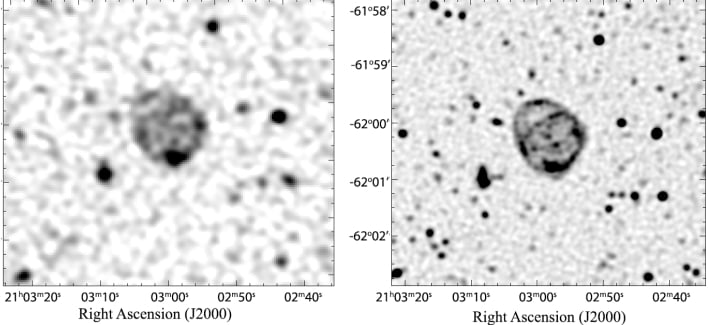These Mysterious ORCs Just Chilling In Space Were Captured In A Stunning Cosmic Photo
The ambiguous ORCs were first discovered in 2019 using the Australian Square Kilometre Array Pathfinder (ASKAP) telescope. ASKAP is a synthesis array that consists of 36 colossal dishes located in the Murchison region of Western Australia. Each dish is 12m in diameter, spread out in two dimensions with baselines up to 6km.
The latest images were captured by the South African MeerKAT radio telescope, which is a precursor to the Square Kilometre Array (SKA) telescope. The new image and data, also known as ORC1, was presented in a research paper online on Tuesday.
The paper says that ORC's strongly resemble supernova remnants, or planetary nebulae. However, their "Galactic latitude distribution" rules out any Galactic origin. Another resemblance is that of the rings of radio emission sometimes viewed in nearby starburst galaxies, but the nonappearance of an optical counterpart to the diffuse radio emission rules out this thought process. Other potential explanations have also been ruled out.
There are, however, three possible hypotheses for the origin of ORC's according to the research authors. One is a spherical shock wave from the central galaxy, potentially from a cataclysmic event like that of a merger of a supermassive black hole. Another option is a double-lobed radio Active Galactic Nucleus (AGN) seen end-on. A third option is the result of interactions between galaxies. At this point, there are no widely agreed upon explanations for the mechanism that produces them.

Researchers have examined the environment of three single ORC's, and found that while ORC1 is found in a significant overdensity of galaxies, the other two are not. They state that ORC1 gives a density 9 times higher than that of galaxies in the same redshift range in the surrounding area. It is thought that several of these galaxies are actually located within the shell of the ORC itself.
"We know ORCs are rings of faint radio emissions surrounding a galaxy with a highly active black hole at its center, but we don't yet know what causes them, or why they are so rare," stated lead author Ray Norris, a data scientist and astrophysicist from Western Sydney University and Commonwealth Scientific and Industrial Research Organisation.
The team hopes to expand on their findings while accessing "even more sensitive radio telescopes", such as the Square Kilometer Array (SKA) Observatory. Construction on this mammoth telescope, the world's largest radio observatory, began in 2021 and is expected to be to operational in 2027.
Top Image Courtesy of The EMU team, using ASKAP and MeerKAT radio continuum data

